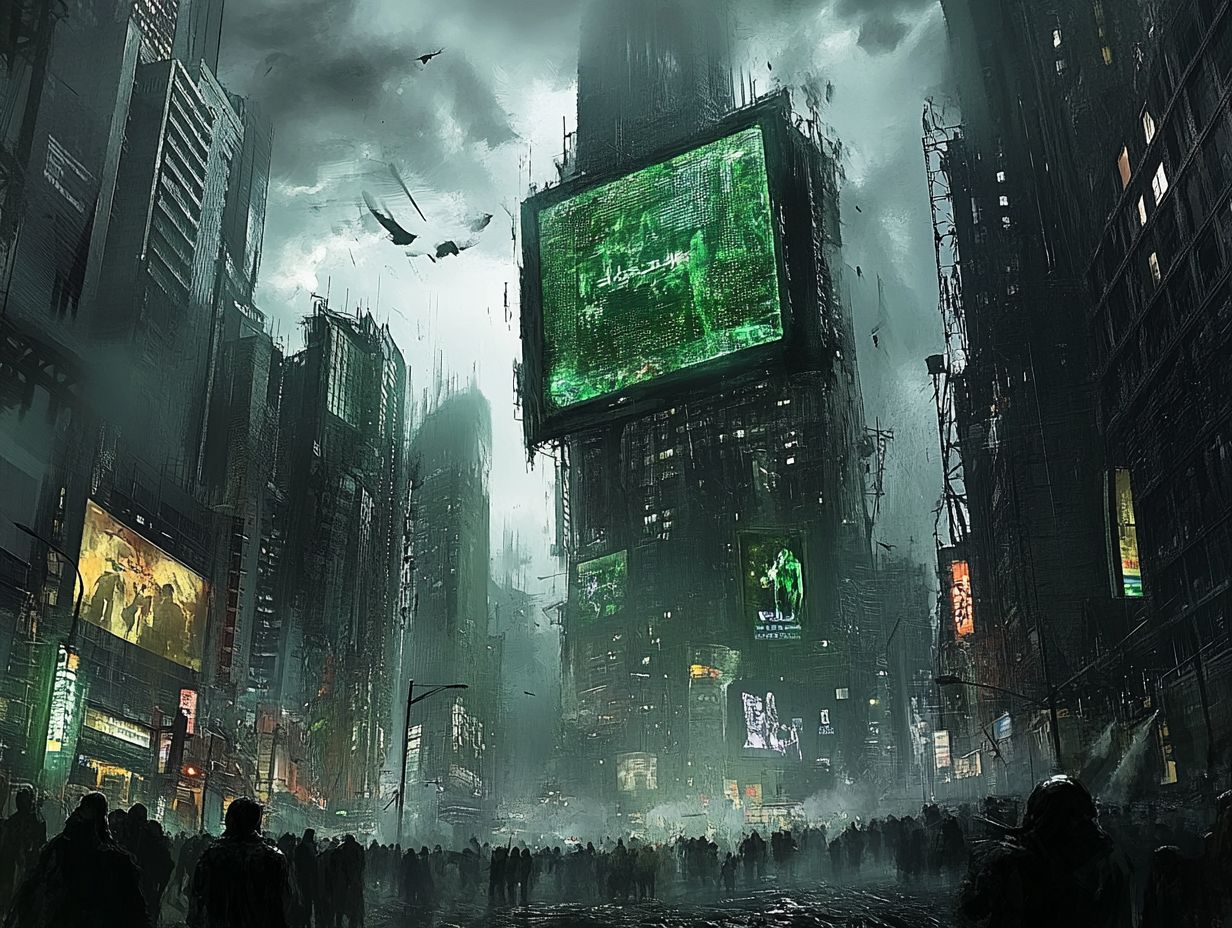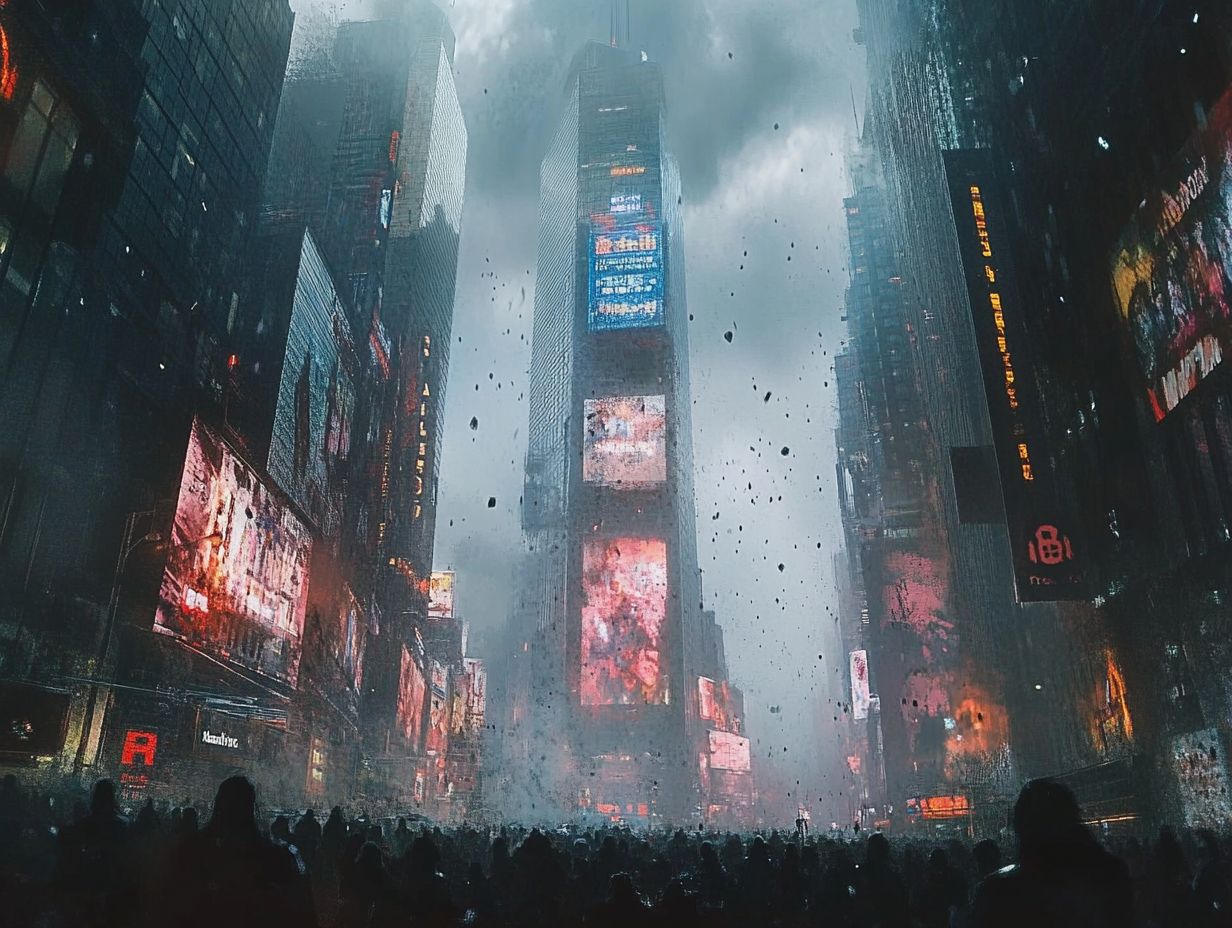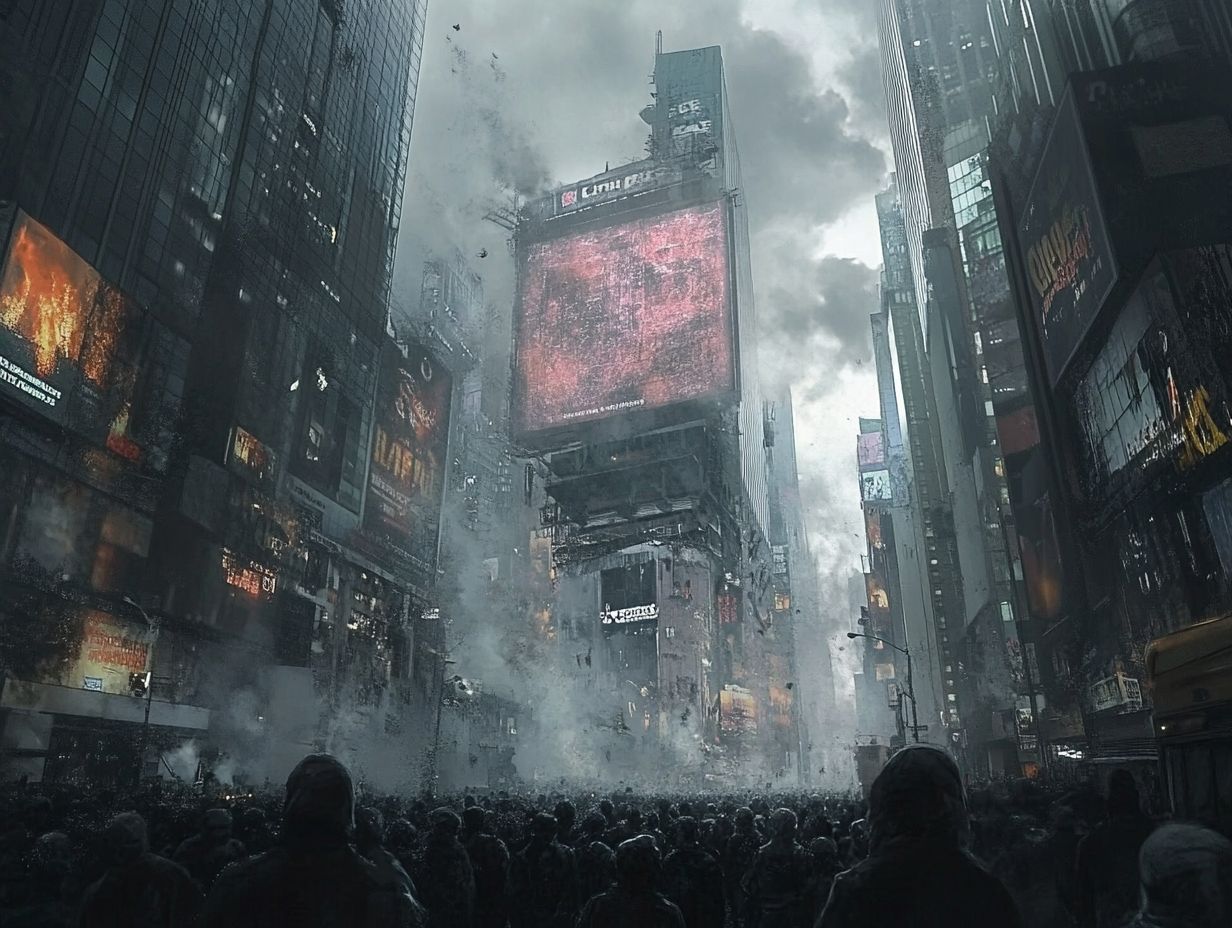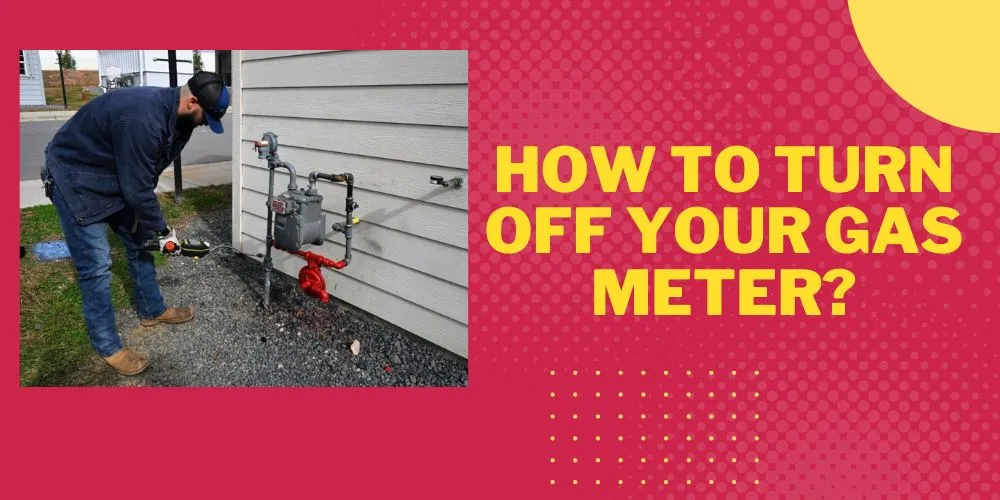Understanding Dystopian Cities

Dystopian cities are marked by a complex and interdependent relationship between technology, architecture, society, and culture. Key characteristics of these cities include the consequences of overpopulation, resource scarcity, and environmental degradation, often stemming from the conflicting aspirations of modern civilization.
Additionally, the future of governance and community engagement is influenced by innovations in surveillance and control. The presence of decaying public spaces and infrastructure raises significant questions about social stratification and the psychological effects on residents of dystopian cities.
These aspects can serve as a lens through which to reevaluate urban planning and the resilience of societies.
Defining the Concept
Dystopian cities refer to urban settings where society has deteriorated, often as a result of oppressive near-future governments. These environments typically lack community, feature extensive surveillance, and exhibit a stark divide between social classes.
Historically, such urban landscapes have been constructed as reflections of society’s deepest fears regarding potential collapse, frequently triggered by technological errors, authoritarian regimes, or economic breakdowns. Dystopian literature, ranging from the grim realities depicted in George Orwell’s ‘1984’ to the bleak landscapes portrayed in Aldous Huxley’s ‘Brave New World’, serves as cautionary tales that highlight the repercussions of unchecked governance and the absence of community.
These narratives critique rapid urbanization and environmental degradation while questioning the values upheld by society. They invite readers to reflect on the significance of freedom and community in a world dominated by surveillance, fostering an essential conversation about the future of urban design and societal values.
Factors that Contribute to Dystopian Cities
Climate change, resource scarcity, and overpopulation are interconnected factors that contribute to the emergence of Dystopian Cities by putting pressure on urban infrastructures and exacerbating social inequalities. As cities expand, challenges related to governance and public health also increase, leading to social stratification and the potential for unrest.
Political and Social Structures

The political and social structures within dystopian cities negatively affect the quality of life for residents by exacerbating inequality and social stratification. These environments often feature limited civic participation, leading to community disengagement and a disconnect between governance and the community’s needs.
As a result, there may be inadequate public services, such as healthcare and education, which are essential for community well-being. In these settings, power is concentrated in the hands of a few individuals, marginalizing groups that lack a voice in decision-making processes.
This neglects critical issues such as public safety, economic opportunities, and environmental concerns, further destabilizing the community. The absence of good governance and inclusive policies can create a cycle of hopelessness and despair, where residents feel powerless to effect change, ultimately diminishing their overall health and quality of life.
Environmental and Technological Factors
Environmental Factors: Dystopian cities are typically characterized by environmental degradation resulting from climate change, as well as urban heat islands that elevate ambient temperatures.
Technological Factors: In these cities, technology is often employed to facilitate government control and social stratification, increasing the ease of surveillance and eroding individual privacy. As these technologies become more integrated into daily life, ethical and political concerns regarding the evolution of urban living in this direction become increasingly pronounced.
Environmental and Technological Factors: As cities face the challenges posed by climate change, technological solutions like the development of smart cities are becoming more prevalent. These smart cities leverage data and technology in their design to enhance resource management. Key objectives include waste reduction and improvements in public transportation; however, they also confront challenges related to rising temperatures from climate change.
For instance, the built environment in smart cities can include green roofs and vertical gardens to mitigate the urban heat island effect, showcasing how sustainable practices and advanced technologies can collaborate to create more functional urban spaces. Nonetheless, as urban environments increasingly depend on digital infrastructure, issues of equity and accessibility emerge, along with the long-term implications of data collection on individual liberties.
The Impact of Dystopian Cities on Society
The consequences of living in dystopian cities manifest in psychological impacts, health issues, and a loss of community cohesion. As urban environments grow increasingly inhospitable due to crime, inequality, and a lack of security, the quality of life for urban residents deteriorates.
Effects on Mental Health and Well-being

Living in dystopian cities can have a detrimental impact on mental health and well-being, often leading to feelings of isolation and hopelessness due to urban decay and societal neglect. The psychological effects of residing in such environments can manifest in various ways, including anxiety, depression, and a pervasive sense of hopelessness.
These issues are exacerbated by a lack of community connection, as the absence of social support systems can intensify feelings of isolation. In contrast, vibrant urban areas that prioritize community engagement, accessible public spaces, and mental health resources typically promote better mental and emotional health outcomes.
In these supportive environments, strong relationships and public programs contribute to building resilience. Thus, the interaction between community and urban environments is crucial in determining mental health outcomes, highlighting the necessity for city planners and policymakers to integrate psychological factors into the design of urban spaces.
Inequality and Social Issues
Inequality and social issues are prevalent in dystopian cities, where social stratification creates a divide between the rich and the poor, often resulting in homelessness and economic collapse. This inequality undermines community engagement and heightens tensions within society.
The stark realities of urban life reveal how a small elite benefit from systems designed to drive large numbers of people into poverty. In such contexts, the gap between those who have access to resources and opportunities and those who do not continues to widen, creating a poverty trap that is difficult to escape.
For instance, the proliferation of encampments has become a symbol of the failures of a system that allows individuals to fall into homelessness and poverty. Meanwhile, neighborhoods in economic decline often lack the resources necessary to maintain public services and infrastructure.
As residents grapple with these systemic challenges, community dynamics shift, leading to weakened social ties and an increasing urgency for reforms that address the root causes of these inequalities.
Examples of Dystopian Cities
Examples of dystopian cities encompass both fictional and real locations that have transformed into dystopian environments. These cities may serve as urban legends that warn society about the dangers of dystopian development and urban decay, or they may reflect the harsh realities faced by millions around the globe.
The following examples of dystopian cities illustrate the potential consequences of our collective future.
Real-life and Fictional Examples

Real-life examples of dystopian cities, particularly those affected by gentrification and poverty, closely parallel the fictional portrayals found in literature and film, where urban culture often mirrors societal fears and psychological impacts.
Notable fictional settings from dystopian literature explore themes of control and surveillance. Both real and imagined environments reveal deeper truths about human existence, emphasizing the struggle for survival in oppressive circumstances.
In novels like “1984” and films such as “Blade Runner”, the stark contrasts between affluent areas and dilapidated neighborhoods reflect these societal concerns. Such portrayals encourage a critical examination of our world, prompting discussions about power dynamics, inequality, and the effects of capitalism.
As communities confront these challenges, the lessons gleaned from both reality and fiction become increasingly vital in shaping strategies for creating more equitable urban landscapes.
Creating Sustainable and Equitable Urban Environments
Developing sustainable and equitable urban environments is essential for mitigating the negative effects of Dystopian Cities and enhancing community resilience.
By promoting innovative urban planning that prioritizes sustainability, these cities can create healthier environments and encourage community engagement.
Strategies for Building Better Cities
Strategies for creating better cities involve comprehensive urban planning frameworks that emphasize sustainability, community engagement, and technological innovation. These approaches aim to develop resilient urban environments capable of withstanding modern challenges.
To effectively promote sustainable urban growth, initiatives such as implementing green infrastructure, encouraging mixed-use developments, and integrating smart technologies play a crucial role.
Involving local communities in the decision-making process not only ensures that the unique needs and preferences of residents are addressed but also fosters a sense of collective ownership of urban spaces. Innovations in transportation systems, such as expanding bicycle lanes and enhancing public transit options, can significantly reduce dependency on fossil fuels and lower emissions.
By prioritizing these strategies, cities can pave the way toward a more adaptable and sustainable future, ultimately improving the quality of life for all urban dwellers.
The Future of Dystopian Cities
The future of dystopian cities will hinge on our ability to adapt to emerging challenges such as climate change, resource scarcity, and technological advancements. These factors will likely shape the trajectory of urban governance and society.
Predictions about urban futures underscore the importance of innovative solutions to mitigate the risks associated with dystopian scenarios.
Predictions and Potential Solutions
The concept of future dystopian cities and potential solutions highlights the crucial role of sustainable practices and adaptive governance in creating equitable urban environments. Given the realities of overpopulation and environmental degradation, proactive measures are essential.
Visionary ideas such as vertical farming, renewable energy integration, and efficient public transportation systems are not merely idealistic; they serve as foundational elements for reimagining urban living in challenging times.
By prioritizing green infrastructure and fostering community-driven initiatives, cities can evolve into resilient ecosystems that support both their residents and the natural environment.
The incorporation of technology enhances governance, allowing cities to leverage data analytics for more effective solutions to challenges such as waste management and resource allocation.
The exploration of future dystopian cities and their potential solutions can help mitigate the pressures of urbanization and pave the way toward a more sustainable and equitable world.


